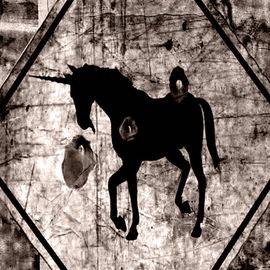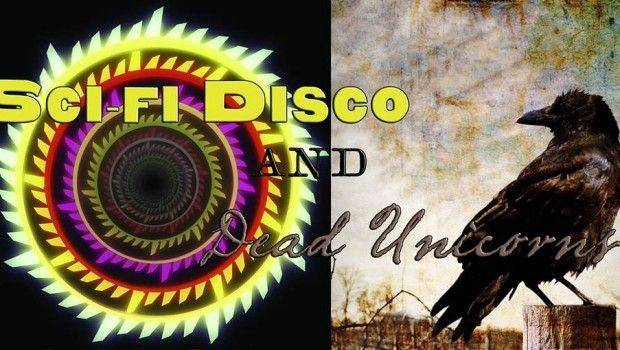
You might not realize it, but, if you love movies, you’re living in a pretty great time. Sure, there are just as many lousy movies as ever, and maybe more, but there are also technological advances that make good movies great and make great movies mindblowing. More importantly, the art of filmmaking has never been more accessible. The technology to make professional-quality movies has never been more readily available, and the local Champaign-Urbana film scene is a direct beneficiary of such advances. Which means that, if you love movies, you’re also living in a pretty great town.
People in this area are making movies, folks. Good ones. And getting better all the time. And the insane array of talented actors on display on various local stages are getting a chance to shine in a whole new venue. We’ve profiled actors like Bill Kephart, Mike Trippiedi, and Joi Hoffsommer previously on Smile Politely, as we’ve discussed the Up the Creek webseries and this month’s thriller House of Thaddeus.
Now the film community has another offering, a double-feature of local short films that promise an imaginative, innovative good time.
The first half of the double-bill is Once Upon a Time in the 1970s, a webseries created and directed by the team of Chris and Anne Lukeman. The second, a bleak futurescape called Heartshot, is directed by Thomas Nicol.
The Art Theater Co-op, our favorite local purveyor of film and entertainment, is presenting the two-fer this Wednesday night, and I had the good fortune to speak with the creative teams involved.
*****
The synopsis of Once Upon a Time in the 1970s goes as follows: “In the probably-alternate 70s, an ominous portal hangs in the sky and killer robots walk the streets. Scientist heroes must fight evil with rayguns and disco in this “transistorpunk” science fiction adventure.” I have to admit that pretty much every word in that description struck me as awesome, so I was intrigued to know a little more about the project. For that, I went to its directors, Chris & Anne Lukeman, who were kind enough to answer some questions (jointly) via email. Chris is pictured below right, with his lead actors, Jonathan Harden (left, shirtless) and Thomas Nicol (background center). You’ll hear more about Mr. Nicol later. First, let’s meet the Lukemans.
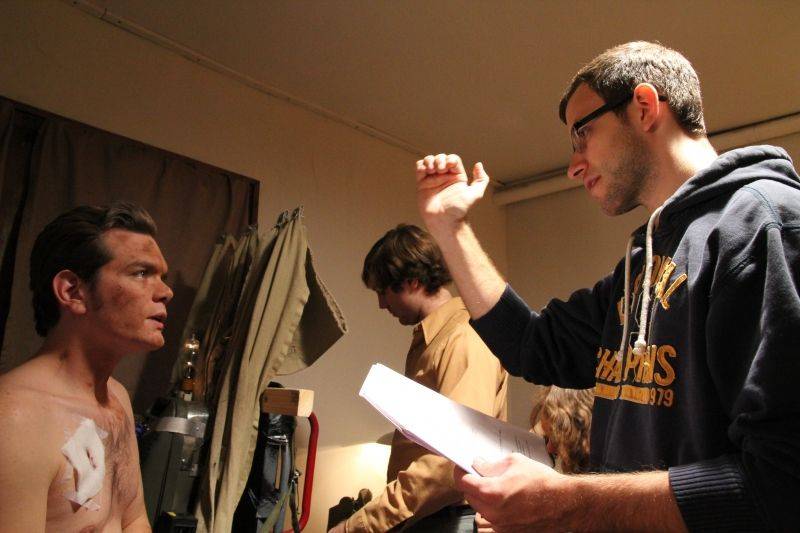
Smile Politely: Could you describe the concept of the film and where its inspiration came from?
Chris & Anne Lukeman: The story is told in a series of short films, each one taking place in a different time period in the 70’s. We have screened many of these shorts in town over the past several years, at events like the yearly New Art Film Festival and the Freeky Creek Film Festival, but this is the first time that they have been presented together locally. The films are planned to be released on the internet over the next several months as separate episodes of a webseries.
SP: Why the 1970s, specifically, for the setting?
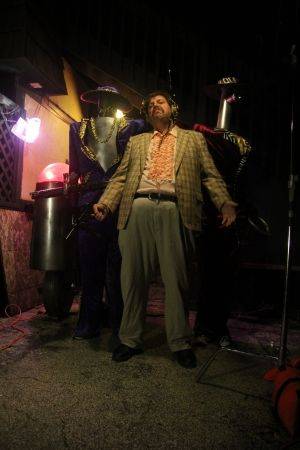 Lukemans: We chose the 70s because the technology is just so fascinating. It is areally awesome time period visually with the transition from analog electronics like vacuum tubes to transistors and more complicated circuitry.
Lukemans: We chose the 70s because the technology is just so fascinating. It is areally awesome time period visually with the transition from analog electronics like vacuum tubes to transistors and more complicated circuitry.
We wanted to do something in the sci-fi comedy vein of Ghostbusters with a bit of the Indiana Jones sense of adventure. Our tone shifts a bit over the course of the project, from a relatively serious mystery to having some more fun with the situations, but the episodic nature really lends itself to that kind of experimentation.
SP: How long has the project being in the works?
Lukemans: This project has been in development for over two years. We started taking the first short, “1972” (available here), to festivals in 2011; since then, we have been on and off production every several months working on the rest. It is an incredibly effects-heavy story, which has meant a lot of time both planning and building detailed props, and then sitting in front of the computer every night for weeks patching everything together.
One of the big things that sets this project apart from a lot of lower-budget films is how much we use practical effects. Our robots (seen above, with a villain played by Matt Fear) aren’t computer generated; they are physical props we had on set. Some were worn as costumes, but our most prolific one is an 8-foot-tall, 80-pound puppet that took 7-9 people to operate, depending on the shot. We’ve taken the robots to comic conventions and film festivals to promote the movies, and audiences love seeing them and really seem to appreciate the approach.
SP: You mentioned being in production for around two years…. How many people worked on this project, in total? I’m trying to establish for SP readers the size of the local film community and some of its key players.
Lukemans: These films could not be made with out incredible support from the C-U community. Nearly 200 people have been involved in some capacity. People don’t realize how unique it is that the community has so many talented independent filmmakers collaborating and producing. Pair this with the stellar acting talent and local music scene, and it opens up a lot of possibilities for C-U to be noticed on the national level. We cast a lot from local theatres, the university, and the improv groups, and we work with local musicians such as Guido Esteves, who composed our original 70s and disco music, and bands like Duke of Uke and The Fights, who contributed to the score with existing music.
Every year, the area produces several feature films and dozens of great shorts. Those numbers just shouldn’t even be possible in a town this size, and it says a lot about the arts-supporting mindset that has been built here. We can build amazing production design with help from businesses like the I.D.E.A. Store and Analog Outfitters (our 70s tech experts); work with actors from the Station, CUTC, Parkland, the U of I, or improv groups; use local businesses for locations; score the movie with local music; and premiere the finished film at the Art Theater before taking it to a national audience.
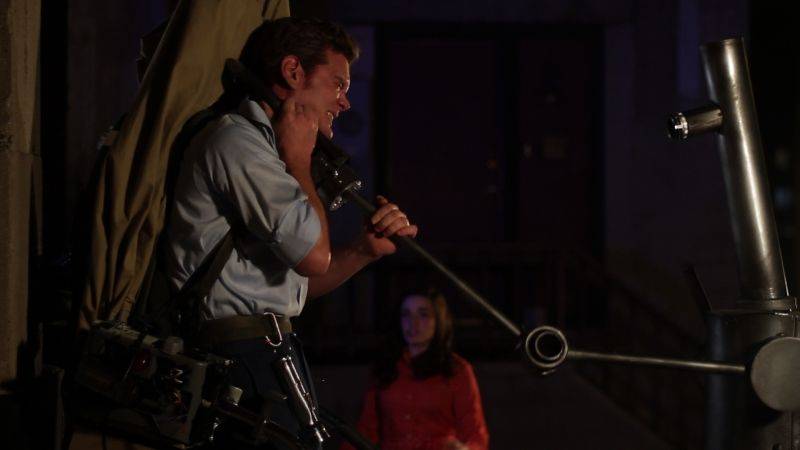
SP: How long have you been making movies? Where did this passion start, for you?
Chris Lukeman: I started filmmaking in high school, still using the big old VHS cameras. My interest really picked up in college, though and thankfully the technology picked up with it. I went to the University of Illinois for undergrad and was heavily involved in the student filmmaking group Illini Film and Video. While there I produced the horror-comedy feature film The University of Illinois vs A Mummy. [Editor’s note: That’s a fantastic title.] Managing that project was essentially my film school. Since then, I’ve had a lot of success with short films, taking several of them to festivals and having them screen to national audiences like on VH1 and Comedy Central.
Our films may be ridiculous, but my real passion is telling truly unique stories. Even if we’re dealing with tropes, I always push to make sure we’re dealing with a subject in a novel way, or playing with the viewer’s expectations in some way. I can personally guarantee you that there are a lot of things in the Wednesday show that you haven’t ever seen before.
SP: I’m going to go ahead and grant that premise. Can’t wait.
*****
The second film in the Art’s sci-fi double-bill is Heartshot, which promises a heavier, moodier experience, despite its concentration on an animal that graces the backpacks of many seven-year-old girls. The film is described as taking place in a dystopian near-future, one in which unicorns have been genetically engineered and reintroduced. In this reality, the film’s protagonist, a scientist played by local actor and filmmaker Mike Trippiedi, poaches the fantastical beasts in order to support his drug habit.
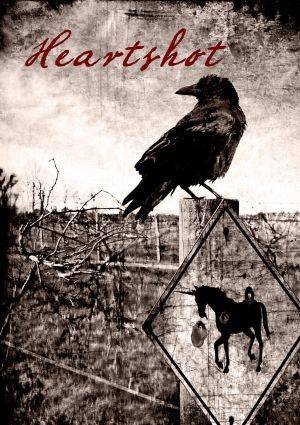 The following background on the film was available on the Heartshot fundraiser campaign website: “Heartshot is a cursed story. That’s not just a poetic way of saying it’s dark. Written about 25 years ago by Mike Byers, it follows a drug-addicted scientist who turns to poaching genetically engineered unicorns to support his habit. So it is dark, but it’s also literally cursed. While Mike had no trouble selling it, it proved impossible to publish. Several different publishing houses bought the story, but every single one folded before they could print it. Deciding he had killed enough businesses, Mike retired the story…until 2010, and the Freeky Creek Film Festival, run by central Illinois winemaker and filmmaker Joe Taylor. Mike approached Joe after the fest, and offered him the story as the basis for a short film. Being the honest guy he is, he also warned Joe about the curse. But, never one to pass up a good curse, Joe decided to take it. He’s now suckered several of his friends into helping make this a reality — award winning filmmakers, actors, and model makers.”
The following background on the film was available on the Heartshot fundraiser campaign website: “Heartshot is a cursed story. That’s not just a poetic way of saying it’s dark. Written about 25 years ago by Mike Byers, it follows a drug-addicted scientist who turns to poaching genetically engineered unicorns to support his habit. So it is dark, but it’s also literally cursed. While Mike had no trouble selling it, it proved impossible to publish. Several different publishing houses bought the story, but every single one folded before they could print it. Deciding he had killed enough businesses, Mike retired the story…until 2010, and the Freeky Creek Film Festival, run by central Illinois winemaker and filmmaker Joe Taylor. Mike approached Joe after the fest, and offered him the story as the basis for a short film. Being the honest guy he is, he also warned Joe about the curse. But, never one to pass up a good curse, Joe decided to take it. He’s now suckered several of his friends into helping make this a reality — award winning filmmakers, actors, and model makers.”
Full disclosure, I found this story too good to pass up, so I contributed a paltry little donation to the cause. As a lover of local films, local theatre, and local actors, I couldn’t be happier that this project has come to fruition. If you’ve seen the intriguing trailer (below), then you’ve seen as much of the finished product as I have. But you have to admit, the idea is cool as all giddy-up.
I checked in with the film’s director, Thomas Nicol, as well as two of its stars, Mike Trippiedi and Bill Kephart, to find out more about the story, the production, and their experience working on it.
SP: First off, where does such an idea come from? What happened in that first moment when you thought, “This should be a film?”
Thomas Nicol: Heartshot is an adaptation of a short story by writer/musician Mike Byers. He was caught in gridlocked traffic one day, directly behind a mini-van sporting a plush unicorn stuck to the rear window. In that moment of frustration, he decided to write a dark, depressing story featuring unicorn poaching.
SP: How long has this process lasted, from script to finished product? I have received the occasional email update about the shooting, etc., but I’m curious as to how long a film takes to get made.
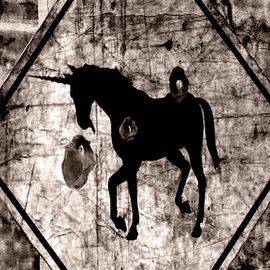
Nicol: Mike Byers first approached Joe with the story after seeing a darkly humorous unicorn short play at the inaugural Freeky Creek Film Festival Joe held out at Sleepy Creek Vineyards around Halloween of 2010. Joe loved the story and worked on adapting it to a screenplay on and off over the next year.
It was early 2012 when he asked me to help direct, and I was delighted to help out. We put the finishing touches on the script together, and began shooting at the end of February. As we shot through March, we ran a crowd-funding campaign on indiegogo to raise financial support from the community to buy the necessary materials for the practical creature effects.
Our intent was to wrap principal photography by spring. However, a combination of inevitable delays and an earlier spring than we were anticipating prevented us from completing the short in one go. Our wooded locations that were so beautifully bleakand brown in February and March were too lush and green to use until [the following] November. The forced hiatus allowed us to step back, slow down, and prepare for the more involved creature effects shots.
We had a nearly complete rough cut by January, and pushed through to get the short polished to play at the New Art Film Festival in April. As it kicked off its festival run this summer (including a “Best Short” award at the H.P. Lovecraft Film Festival in Portland), we’ve worked on compiling a pile of special features for the DVD, which should be completed very soon.
The cast and crew were wonderful through this whole process, graciously coming out to shoot weekend after weekend, working in freezing and sweltering conditions, putting in long, late hours to prepare props, etc. Everyone knew we had something special, and we were all invested in making it the best short we could. This short could not have happened without this community, so generous with its time, talents, and resources. We’re all lucky to live here right now.
SP: I know many of them from the local theatre community, and I’m wondering what the casting process is like for our local film scene. (And how people with genuine interest might get involved.)
Nicol: Casting was so long ago, I can’t imagine anyone else playing any of the roles. But obviously at some point we had to have made some decisions. I recall casting being a fairly quick process, however. One or both of us had worked with most of the cast on one project or another, or had been impressed by their work elsewhere.
That’s how many local films are made: sometimes auditions will be held, but more often than not an actors’ previous work (on screen or stage) is valued over a formal reading. If an actor wanted to get into local film, coming to meet filmmakers at Champaign Movie Makers would be an excellent first step. Meetings are held the third Tuesday of the month from 7:00 PM to 9:00 PM at Shatterglass Studios. We also hold quarterly screenwriters’ meetings, including a live-read by local actors of developing scripts, which is an easy, low-commitment way to get on filmmakers’ radar. If any actors are interested in helping out there, they should contact us via email at [email protected]!
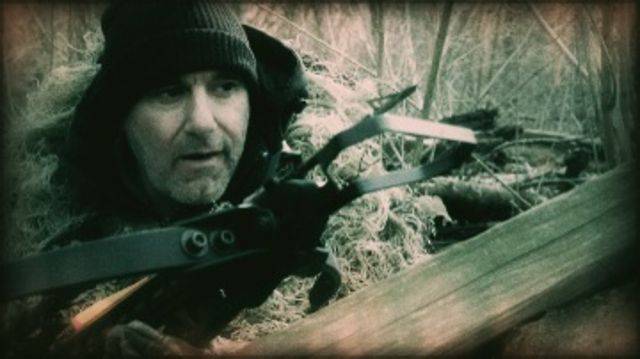
SP: And now a word with Mike Trippiedi (pictured above, in character). Mike, what was your experience like, as an actor?
Mike Trippiedi: As an actor, Heartshot was very difficult to shoot for many reasons. Thomas, Joe, and the Director of Photography, Tim Meyers, were going for a certain look, which we could only get by filming in the dead of winter. Spring came early so we ended up having to wait until the following year to finish filming, so not only was it incredibly cold shooting in bare woods and cold rivers, but we had to complete scenes that we had started shooting almost a year earlier. Trying to recapture the character, energy, feel, and look of several unfinished scenes was one of the most difficult things I’ve ever done as an actor. I’d do it all again, though, to be able to work with such a talented and generous cast and crew: Steve Keen, Bill Kephart, Chris Lukeman, Cara Maurizi, Ellen Skottene, Thomas Nicol, Tim Meyers, and Joe Taylor.
SP: Was anything besides the weather conditions that made it tough?
Trippiedi: There were some scenes that involved the animation of models and use of green screen. As an actor this is extremely challenging because you have nothing to play off of while filming the scene. You hope what you imagine in your own mind will believably match with the animation and editing.
Also, a lot of my dialogue was sparse. In fact, many of my scenes had no lines, which meant that I had to convey my actions through body language. You hope you can pull off without over-acting. This is where an actor really has to trust the director and the director has to trust himself enough to guide the actor through the scene. Thomas Nicol did this flawlessly, and I owe my performance to him. I showed up the first day of filming trying to focus on the character’s drug addiction, and Thomas suggested I focus more on his humanity. Following that simple piece of advice, forced me to put the character ahead of the performance, which is what an actor needs to be reminded of every now and then.
It was a difficult shoot, but would do it again if asked. I am extremely proud to be a part of this film.
SP: Bill Kephart (pictued below), who was featured in our House of Thaddeus article, also appears in a major role. What was your involvement, Bill? And who do you play in the movie?
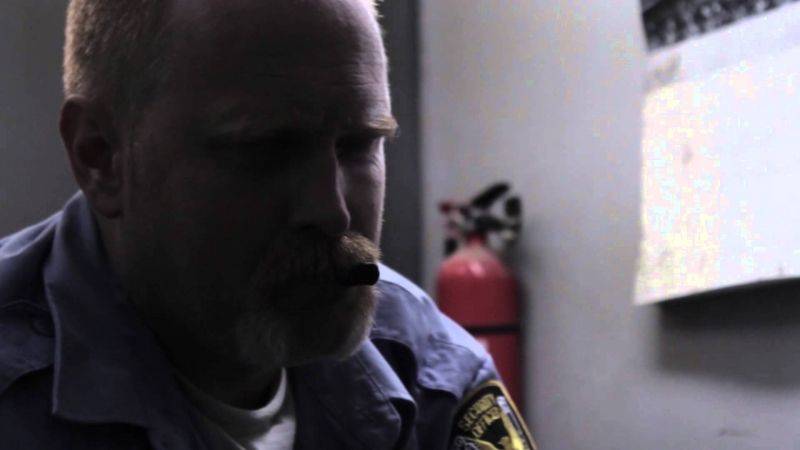
Bill Kephart: I did some SFX makeup for this one (FYI, a good honey-mustard makes great pus), and a little prop work, but mainly, I was an actor. I play a jaded good-ol-boy, a security guard named Jerry Mangrum. It’s through Jerry that we learn most of the backstory of this dystopian future, where genetic experiments have run amuck and are now banned. The oddities that were created are now relegated to dangerous government preserves where only researchers are allowed to study them.
SP: Did you find acting in this type of film problematic?
Kephart: Jerry was the challenge I’d been looking for. He’s a bit of a “character” in his real life, but he had to be played realistically, so I had to find that fine line. It was a complete joy being allowed to craft him. For instance, he had a line of dialogue that I thought would sound great in sort of a backwoods accent, so I built my character around how that single line should be said, and the rest just followed. The part was so well written that most of the character choices were made for me. Before my scenes were shot, I got to see some of the footage they’d begun editing, and when I saw how great the film looked and the level of the performances turned in by Mike Trippiedi and Steven Keen, I realized the bar was set really high on this project. It was clear from the beginning that everyone involved in this project was giving their absolute best.
SP: Do you have a favorite scene or experience from filming?
Kephart: Other than [Editor’s Note: the following several words have been deleted to avoid spoilers…] the most memorable part for me was filming the guard shack scene. My character, Jerry, chews on cigars (a habit of mine I conveniently added to the character), and we had a long shoot where I ended up chomping on cigars for hours. I unwisely insisted on actually chewing on cigars for the entire shoot. By the end of the night, the room was spinning and I was green. Still, loved every minute of it!
*****
The Art Theater Co-op has titled this double-feature “Sci-Fi Disco and Dead Unicorns,” which is about as good a description of the proceedings as I can imagine. The event is a Late Night program and will begin at 10:00 PM, to be followed by a Q&A with the filmmakers after both films have run.
We here at SP have tried to get the word out lately about local film, and we will continue to do so, but now it’s up to you, gentle reader. Don’t just say “That’s cool” and stay home and watch TV. Go see some local film. If you like what you see, get involved. Attend a Champaign Movie Makers meeting if you’re a creative type, or just shoot them an email and ask how to donate to the cause.
Local talent is a precious resource for our community, and it has be cared for and cultivated.
Here’s to more premieres, more film festivals, more webseries, and more crazy-ass ideas that wind up on the big screen at the Art…and beyond.








